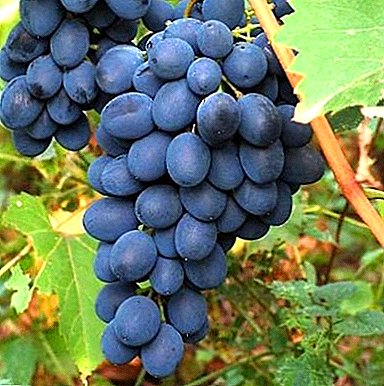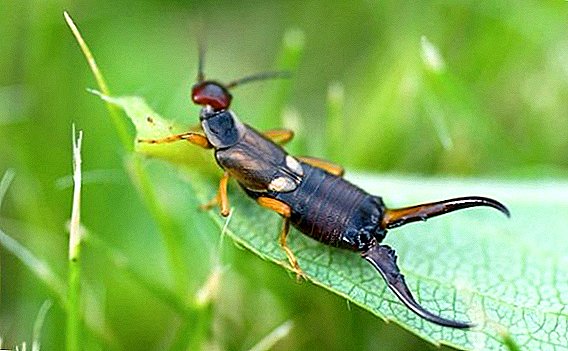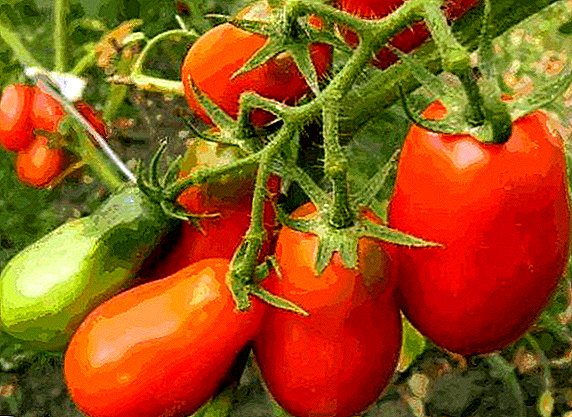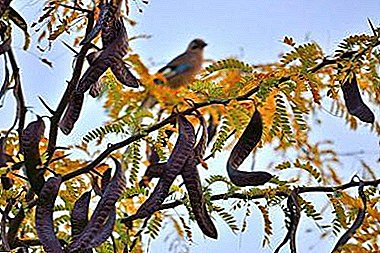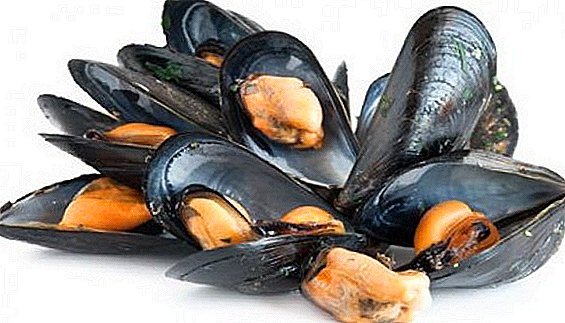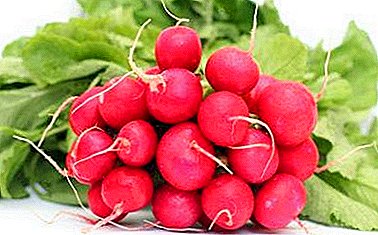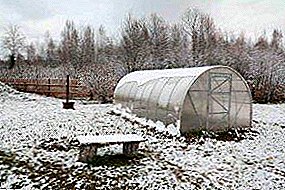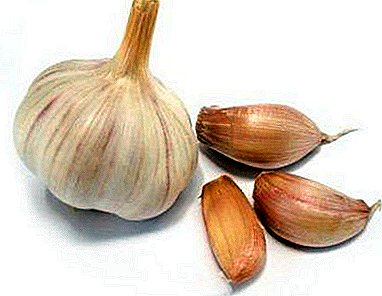 Fruit tree mulberry, having also another name - Mulberry tree or mulberry, unfortunately, not the most frequent inhabitant of gardens or cottages, because not all gardeners are familiar with this plant, which gives very tasty and healthy fruits. In this article we will study in more detail the white mulberry, its description and features of cultivation and reproduction.
Fruit tree mulberry, having also another name - Mulberry tree or mulberry, unfortunately, not the most frequent inhabitant of gardens or cottages, because not all gardeners are familiar with this plant, which gives very tasty and healthy fruits. In this article we will study in more detail the white mulberry, its description and features of cultivation and reproduction.
Important! Eating berries of mulberry growing near roads and industrial plants is not recommended because they absorb toxins and heavy metal compounds.
White mulberry: description
White Mulberry (Morus alba) came to us from China and already fell in love with some gardeners. The height of this spreading tree reaches 16-20 meters, while the thickness of the trunk can be up to 0.8 m. The root system is powerful, dense crown has a spherical shape. The color of the young branches varies from grayish-green to brownish, the fissured bark of the trunk is often brown in color. Herbal leaves are oval-shaped with a pointed end; one tree has both dissected and whole, soft to the touch. The color of the leaves in the summer - a rich green color, which in the fall becomes light yellow. Flowers of white color, inconspicuous in appearance, are prone to self-pollination.
Dioecious trees are dioecious, in the beginning of summer they yield a harvest of sweet and juicy seed-berries, which look like raspberries. The white mulberry gives fruits up to 4-5 cm long white, pink or black colors, edible fresh and dried, as well as for preservation. In some countries, mulberry trees are grown to feed the silkworm and produce natural silk threads.
Did you know? Mulberry - a real tree-survivor, under favorable conditions, lives up to 300 years.
Features planting white mulberry
 The abundant fruiting of white mulberries begins from the 5th year of life, at the same time, the male tree of fruits will not give, but will only delight in its appearance. For this reason, it is recommended to use a 3-4-year-old sapling, which has already given the first berries, for planting fruit trees on its plot. So you are guaranteed to get a fruitful mulberry tree.
The abundant fruiting of white mulberries begins from the 5th year of life, at the same time, the male tree of fruits will not give, but will only delight in its appearance. For this reason, it is recommended to use a 3-4-year-old sapling, which has already given the first berries, for planting fruit trees on its plot. So you are guaranteed to get a fruitful mulberry tree.
Choosing a landing site
Planting mulberries is carried out at the end of autumn, before seasonal rains, or in the middle of spring, before the sap flow period. The photophilous mulberry needs protection from cold wind currents, so the mulberry requires careful selection of a landing site, on which tree development and care will depend. Landing on the southern slope is most favorable for the plant. Mulberry will grow well and bear fruit in loose loamy or sandy loam soil. The plant does not accept saline, marshy or dry sandy soil. Where mulberry grows, the groundwater level should be no more than 150 cm.
White Mulberry Planting Pattern
The planting pit for white mulberry should be dug at least 2-3 weeks before planting to stand on the ground. The landing scheme of the mulberry tree is 5 * 4 meters. If you plan to plant a sapling bush mulberry, apply a scheme of about 2 * 3 meters. The landing pit is excavated to a depth of 0.6 m, and its size is approximately 0.7 * 0.7 m. The earth is mixed with humus from the pit, some are covered in the center in the form of a mound, on which the seedling is placed and sprinkled with the rest of the nutrient mixture.
Important! The mulberry root system is fragile, the roots break off easily, so the seedling should be planted very carefully.
White mulberry: growing features
 The mulberry tree is considered one of the most unpretentious plants, not requiring excessive efforts to grow it, but it needs care and timely care. Let us consider in more detail how to care for white mulberry so that the tree grows well and has abundant fruit for many years.
The mulberry tree is considered one of the most unpretentious plants, not requiring excessive efforts to grow it, but it needs care and timely care. Let us consider in more detail how to care for white mulberry so that the tree grows well and has abundant fruit for many years.
Mulberry White Soil Care
The white mulberry, when it is grown on the plot, needs moderate watering from April to July during droughts, if the spring months were rainy, summer irrigation is carried out only occasionally. Watering is carried out at the rate of 10 liters of warm water per adult tree. From the middle of summer and throughout autumn, the mulberry tree is not watered in order to avoid damage during frosts and with sharp fluctuations in temperature during the winter dormancy period. The soil in the wheel circle should be loosened regularly, preventing the formation of a dry crust, and also timely remove all weeds that can deplete the soil. It is recommended to mulch the soil around the mulberry tree with sawdust or crushed bark, this will help retain moisture in the soil in summer, and in winter the roots will be protected from freezing.
Features trimming wood
White mulberry, besides caring for the soil, needs pruning and shaping of the crown, which it, as a rule, tolerates very well. Forming and rejuvenating pruning of white mulberry is carried out in spring, before bud break. Sanitary pruning is carried out after the fall of the foliage in the fall, when the air temperature is not below -5 degrees. The shtambovanny mulberry crown is formed in the form of a ball or a cascading cascade, no more than 3-4 meters high and up to 1.5-2 m wide. The annual branches pinch until the end of July, limiting the active growth of the shoots. In autumn, dried branches of a mulberry tree are cut, as well as those affected by pests or diseases, followed by burning plant residues. Young non-lumbering branches freeze in the autumn-winter period, they are removed in the spring, after which the tree releases new shoots. Fruiting mulberry occurs on old shoots, which covers the cork bark.
Top dressing of a mulberry tree
 Until the period when the mulberry begins to bear fruit after planting, its fertilizing is not a mandatory component of tree care, which is fully sufficient for the full development of nutrients introduced into the soil during planting. As the tree becomes fructifying, they begin to feed it. Be sure to fertilize at the stage of fruiting mulberry tree.
Until the period when the mulberry begins to bear fruit after planting, its fertilizing is not a mandatory component of tree care, which is fully sufficient for the full development of nutrients introduced into the soil during planting. As the tree becomes fructifying, they begin to feed it. Be sure to fertilize at the stage of fruiting mulberry tree.
Fertilizing of the mulberry tree begins in early spring during the blooming of the kidneys. To do this, dissolve 50 g of nitroammophoska in 10 liters of warm water, this composition is applied to each square meter. m pristvolny circle. Re-feeding is carried out in early summer, for this chicken manure is mixed with water in a ratio of 1 to 12, or apply complex fertilizers of industrial production in accordance with the instructions. After that, feeding is stopped until the end of fruiting, it will allow the tree to complete the growth of shoots and prepare for winter dormancy. Phosphorus and potash fertilizers can be applied in the fall on the eve of wintering which feed the roots with nutrients, and in the spring the tree will have a reserve of strength for growth and fruiting.
How to care for mulberry in winter
After the sanitary pruning of the mulberry tree was made in the fall, its near-stem circle is filled with fresh mulch or dry foliage and prepared for the winter season. To do this, it is desirable in the middle of autumn to flex the flexible branches of a young mulberry tree to the ground and cover it for wintering with a nonwoven covering material that is pressed to the ground with stones or other weights in order to avoid damage and opening of the mulberry tree. The same covering material should wrap the lower part of the trunk to protect it from rodents feeding on young bark. At the end of the night frosts in early May, the shelter is removed. Such preparatory efforts for winter are needed only in the first years of life of the mulberry to strengthen it and to avoid freezing, adult tree does not need shelter.
Important! If necessary, consolidate the sandy slope, it is recommended to plant mulberry trees, which, with their root system, growing in breadth, braid crumbling soil.
Breeding features of white mulberry
 The multiplication of white mulberry occurs by seed and vegetative method. Seed method is used for growing seedlings, adapted to new conditions, as well as for growing rootstocks for grafting mulberry tree. Since the mulberry grows very slowly in the seed way, the seeds need stratification.
The multiplication of white mulberry occurs by seed and vegetative method. Seed method is used for growing seedlings, adapted to new conditions, as well as for growing rootstocks for grafting mulberry tree. Since the mulberry grows very slowly in the seed way, the seeds need stratification.
To do this, in the fall after collecting fresh mulberry seeds, they are placed for 4-5 days on a damp cloth far from sunlight in a warm room, then the seeds are wrapped in a damp cloth, put this bundle in a plastic bag and put in a refrigerator for 30-40 days. During this time, the seeds swell and increase, they need to be sown in a shallow container, lightly watered, put the container with the seeds in a plastic bag and leave for about 60 days in the refrigerator. After which the container is placed on the windowsill and watered regularly. In the spring, after the soil warms up, the prepared seeds should be planted in open ground at a permanent place of growth.
The vegetative multiplication method of the mulberry tree involves the use of root shoots, grafts - any way that is preferable to the gardener. The most commonly used method is green grafting. To do this, cut fresh cuttings with 3-4 leaves, the lower section should run obliquely under the kidney, and the top one above the kidney, and remove the lower leaves. Prepared stalk should be stuck in the penumbra in moist loosened earth at an angle of about 50 degrees and cover with a covering material or a glass jar for high humidity. Several times a day, the stalk must be ventilated, removing the shelter, and sprayed, thereby moisturizing it. After rooting, the shelter is finally removed, and the plant is transplanted to a permanent place.
Mulberry white: useful properties
White mulberry contains many vitamins, micro and macro, which are due to its many useful properties. Green berries are used for stomach disorders and heartburn, and ripe - for constipation. Berry juice is diluted with warm water and the resulting liquid gargle with sore throat. A decoction of the bark and roots of mulberry helps to heal hypertension, infusions of leaves relieve feverish heat. An infusion of mulberries and bark will help fight off colds and bronchitis, as well as ease asthma. Stress and insomnia will recede with regular ingestion of decoctions of dried mulberry berries, and the nervous system will improve and the body's metabolism will accelerate.
 People suffering from myocardiodystrophy or heart disease, it is recommended to use 200-300 g of ripe berries several times a day for 30 days. The use of mulberry berries is recommended for people whose work involves physical labor, athletes, as well as patients recovering from surgery. Mulberry fruits have a beneficial effect on blood-forming processes. Folk healers treat ringworm with the juice of fresh mulberry fruits, and crushed bark is mixed with oil and is applied to bruises, cuts and wounds for speedy healing.
People suffering from myocardiodystrophy or heart disease, it is recommended to use 200-300 g of ripe berries several times a day for 30 days. The use of mulberry berries is recommended for people whose work involves physical labor, athletes, as well as patients recovering from surgery. Mulberry fruits have a beneficial effect on blood-forming processes. Folk healers treat ringworm with the juice of fresh mulberry fruits, and crushed bark is mixed with oil and is applied to bruises, cuts and wounds for speedy healing.
Did you know? One adult mulberry tree can produce up to 100 kg of berries per season.For easy harvesting of mulberry white, you can use a simple way - Spread polyethylene or thick fabric under the branches ripe berries will fall off themselves, the grower will only have to gather and enjoy their sweetness.



